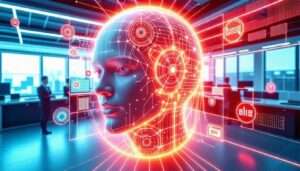In today’s fast-paced world, decisions need to be made quickly to keep up with the demands of daily life. With the rise of technology, we have increasingly looked to automation to streamline tasks and increase efficiency. One such area where automation is gaining momentum is in decision-making processes. Automated Decisionmaking, or ADM, has the potential to make quicker and more data-driven decisions, leading to increased efficiency and accuracy. It can also reduce the risk of bias when implemented with ethical considerations in mind. Additionally, ADM can leverage artificial intelligence and machine learning to make more informed decisions. In this blog post, we will break down the benefits and risks of ADM, and discuss why it is relevant to the reader. With businesses and individuals alike turning to automation to optimize their decision-making, understanding the potential benefits and pitfalls of ADM is crucial in navigating this technological frontier.
As a software developer, I have always been fascinated by the power of automated decision-making. It’s amazing how a well-written algorithm can take over countless routine tasks and make our lives so much easier.
Automating decision-making processes benefits not only organizations but also individuals. For individuals, it saves time and effort by taking over mundane tasks such as scheduling appointments, managing emails, and creating to-do lists. This allows us to focus on more important and creative tasks, increasing productivity, and work satisfaction.
For organizations, automated decision-making saves costs while improving the accuracy and speed of decision-making. It’s no surprise that companies like Amazon and Google have invested heavily in this technology to stay ahead of the game. Automated decision-making analyzes huge amounts of data and provides insights that would have otherwise been impossible or too time-consuming to obtain manually.
However, some may argue that this technology takes away jobs or dehumanizes the decision-making process. While it’s true that automation may lead to a decrease in low-skilled jobs, it also creates new job opportunities in data analysis and AI development. As for the dehumanizing part, I believe that automated decision-making can be a valuable tool when used in conjunction with human decision-making. A computer can do the tedious work, while humans can provide context and creativity to make informed and empathetic decisions.
automated decision-making is here to stay, and it’s up to us to use it responsibly. By embracing this technology, we can improve efficiency, increase productivity, and free up time for more meaningful tasks.
Automated Decisionmaking can lead to more accurate decisions due to data-driven decisions.
When it comes to decision-making, relying on gut instincts and human judgment may not always lead to the best outcomes. This is especially true when dealing with large amounts of data, where it can be challenging to identify patterns and insights accurately. However, with the advent of automation, it's now possible to make data-driven decisions easily and efficiently.
Automated decision-making systems use algorithms and data models to identify patterns and insights in vast amounts of data. By analyzing historical data, these systems can provide accurate predictions, identify opportunities for optimization, and even suggest courses of action.
One of the primary benefits of automated decision-making is that it can lead to more accurate decisions. Humans are prone to biases, emotions, and other factors that can cloud their judgment. In contrast, automated systems rely solely on data, which is analyzed objectively and without personal opinions.
Another advantage is that automated systems can make decisions much faster, allowing companies to react swiftly to changing market conditions or customer needs. Additionally, automated decision-making systems can minimize human error, providing consistent and reliable outcomes consistently.
In today's fast-paced business environment, the ability to make accurate, data-driven decisions is more critical than ever before. Automated decision-making systems can help companies achieve this goal, providing faster, more reliable, and more accurate decision-making with minimal errors. As a result, companies can gain a competitive edge, increase customer satisfaction, and improve their bottom line.
Automated Decisionmaking can reduce bias in decision-making when implemented correctly and ethically.
Automated decision-making, when implemented ethically and correctly, has a crucial role to play in reducing bias in decision-making. As humans, we often fall prey to conscious or unconscious biases that can impact our decision-making negatively. However, automated decision-making relies on metrics and algorithms that are quantifiable and not influenced by prejudice or subjectivity.
One of the significant benefits of automated decision-making is that it eliminates the possibility of human errors and inconsistencies. For instance, it is much easier for a human to get swayed by a persuasive argument or a charismatic personality in a job interview. But, automated decision-making algorithms can rely on objective metrics like educational qualifications, work experience, and other related data to make decisions.
Another benefit is that it enhances transparency in the decision-making process. Automated decision-making algorithms can provide a detailed analysis of the criteria used to make a decision. This transparency can help reduce any fear of bias or prejudice in the decision-making process.
Furthermore, automated decision-making can help reduce systemic biases by focusing on objective criteria and not race, gender, age or any other possibly discriminating factor. It can also help break down the stereotypes and preconceptions that human decision-makers might possess.
automated decision-making can help reduce bias in decision-making by eliminating human error and enhancing transparency. By doing so, it helps break down stereotypes and ensure objective decision-making. However, it is crucial to implement it ethically and correctly to ensure that automated decision-making does not perpetuate bias or prejudice.
Automated Decisionmaking can improve transparency and accountability in decision-making processes.
Automated decision-making can greatly improve transparency and accountability in decision-making processes. By using algorithms and data analysis, automated systems can eliminate the biases and subjectivity that often comes with human decision-making. This ensures that decisions are made objectively and based on factual evidence rather than personal opinions or biases.
Another benefit of automated decision-making is that it can provide a clear audit trail of the decision-making process. This means that any decision can be traced back to its source data and the rationale behind the decision can be thoroughly examined. This provides transparency and accountability to the decision-making process, which is essential in many organizations and industries.
Furthermore, automated decision-making can also provide consistency in decision-making. With automated systems, the same criteria are applied to all cases, ensuring that all decisions are made fairly and impartially. This reduces the risk of errors and inconsistencies in the decision-making process, which can lead to legal and reputational consequences for organizations.
Overall, automated decision-making can greatly improve the decision-making process by providing transparency, accountability, and consistency. As the use of artificial intelligence continues to grow, it is important for organizations to incorporate automated decision-making into their processes in order to improve efficiency and reduce the risk of biased or inconsistent decision-making.
Automated Decisionmaking can leverage advancements in machine learning and artificial intelligence to make more informed decisions.
Automated decision making is becoming increasingly popular in businesses today. It involves the use of algorithms and statistical models to make important decisions with minimal human intervention. There are several benefits of automated decision making including increased efficiency, cost savings, and accuracy.
Automated decision making is much faster than traditional methods of decision making which typically require a lot of human involvement. This means that businesses can be more responsive and make decisions in real time. By eliminating the need for human involvement, businesses can also make significant cost savings. Automation can mean that less staff is required, and fewer errors are made, resulting in reduced costs.
Furthermore, automated decision making can leverage advancements in machine learning and artificial intelligence to make more informed decisions. These technologies can analyze vast amounts of data and identify patterns that humans may miss. This can lead to more accurate predictions and better outcomes for the business.
Moreover, automation reduces the potential for human error, which can otherwise prove costly. It also means that decisions can be made objectively, without being influenced by personal biases or other subjective factors. This can lead to fairer outcomes and increased trust from customers.
automated decision making offers several benefits for businesses including increased efficiency, cost savings, and more accurate decision making. With the advancements in machine learning and artificial intelligence, businesses can leverage these technologies to make better decisions, ultimately leading to greater success.
Conclusion
Automated decision-making has both benefits and risks that must be carefully considered before implementation. The benefits of increased efficiency, more accurate decisions, and reduced bias can greatly benefit organizations. However, it is crucial that automated decision-making is implemented correctly and ethically to avoid any negative consequences. As technology continues to advance, understanding the benefits and risks of automated decision-making can be crucial for staying competitive in the global market. To maximize the benefits and minimize the risks, it is important for organizations to thoroughly evaluate their decision-making processes and consider how automation can be used effectively.
FAQ
Q: Is automated decision-making biased?
A: There is a common misconception that automated decision-making is inherently biased because it is based on algorithms. However, studies have shown that algorithmic decision-making can actually reduce bias compared to human decision-making. For example, a study published in Nature found that algorithms were less likely to discriminate based on race than human judges when it came to predicting the likelihood of a defendant reoffending. Therefore, automated decision-making may actually help promote fairness and reduce bias in certain contexts.
Q: Is automated decision-making always accurate?
A: No, automated decision-making is not always accurate. Like any technology, it is only as good as the data it is given and the algorithms used to analyze that data. It is important to properly test and validate automated decision-making systems to ensure their accuracy. Furthermore, some decisions may be too complex for automated decision-making and may still require human intervention to ensure accurate outcomes.
Q: Does automated decision-making eliminate the need for human judgment?
A: No, automated decision-making is not meant to completely replace human judgment. It is simply a tool to assist humans in making decisions more efficiently and accurately. In fact, most automated decision-making systems require some level of human oversight and intervention to ensure ethical decision-making.
Q: Is automated decision-making only useful for businesses and corporations?
A: No, automated decision-making can be valuable in a variety of industries and contexts, including healthcare, education, and government. For example, automated decision-making in healthcare can assist doctors in diagnosing and treating patients, while in education it can help with personalized learning and adaptive assessments.
Q: Does automated decision-making infringe on personal privacy?
A: Automated decision-making can potentially infringe on personal privacy if it involves collecting and analyzing personal data without consent or in violation of privacy laws. However, automated decision-making can also improve privacy by minimizing the need for humans to access sensitive personal information and by allowing individuals to control the types of data that are used to make decisions about them. It is important to ensure that automated decision-making systems are in compliance with privacy laws and ethical standards.
Sources:
– Jon Kleinberg, Himabindu Lakkaraju, Jure Leskovec, Jens Ludwig, Sendhil Mullainathan. “Human Decisions and Machine Predictions.” The Quarterly Journal of Economics, Volume 133, Issue 1, February 2018, Pages 237–293.
– Angie Drobnic Holan. “Policing algorithms’ accuracy depends on good data.” PolitiFact, 29 April 2019.
– World Economic Forum. “Automated Decision Making: Opportunities and Challenges.” January 2020.




